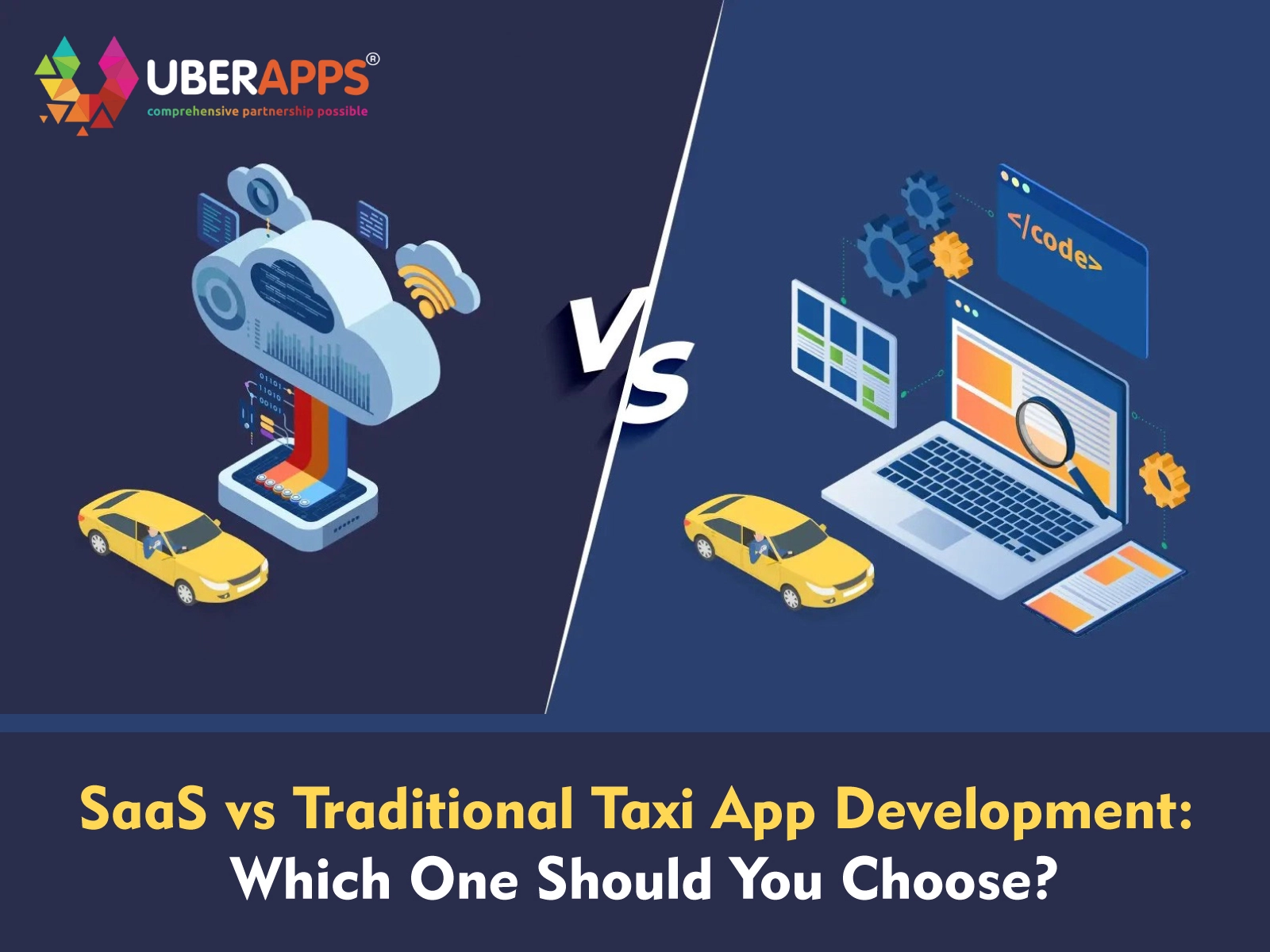
SaaS vs Traditional Taxi App Development: Which One Should You Choose?
The taxi booking industry has transformed dramatically in the last decade. With the rise of ride-hailing giants like Uber, Lyft, Bolt, and Ola, mobility is no longer about phone calls or street hails—it’s about digital-first experiences.
For entrepreneurs and taxi fleet owners, the core question today isn’t “Do I need a taxi app?” but rather:Should I choose a SaaS-based taxi app or traditional taxi app development?
This decision impacts cost, scalability, time-to-market, and long-term flexibility. Let’s dive into a detailed comparison to help you make the right choice.
Launching a taxi booking app requires a crucial decision: should you go with SaaS-based taxi app solutions or invest in traditional taxi app development? Both approaches have unique benefits, costs, and long-term implications. SaaS models promise speed, affordability, and scalability, while traditional builds offer customization and full ownership. This blog explores SaaS vs traditional taxi app development, covering ride-hailing features, in-app payments, operational efficiency, and future readiness. Whether you’re a startup or an established taxi operator, this guide will help you choose the right path to success in today’s competitive mobility landscape.
What is SaaS-Based Taxi App Development?
SaaS (Software as a Service) provides businesses with ready-made, cloud-hosted taxi booking apps on a subscription basis.
- Hosted and maintained on the cloud
- Subscription or pay-as-you-go pricing
- Pre-built ride-hailing app features like booking, GPS, driver management, and in-app payments
- Automatic updates and technical support provided by the vendor
Real-world example: Many startups rely on SaaS-based taxi software to launch quickly without heavy investment.
Takeaway: SaaS taxi apps are fast, affordable, and scalable, making them ideal for startups and small operators.
What is Traditional Taxi App Development?
Traditional development means building a taxi app from the ground up or heavily customizing an existing framework.
- One-time high development cost
- Full ownership of code and intellectual property
- Unlimited customization
- Maintenance and updates managed by your own team
Example: Global ride-hailing leaders like Uber, Ola, and Grab use custom-built platforms that evolve continuously.
Takeaway: Traditional taxi app development is best for businesses seeking full control, unique features, and long-term ownership.
SaaS vs Traditional Taxi App Development: Key Comparisons
1 Development Cost & Budget
SaaS Taxi Apps: Lower upfront investment with predictable monthly or annual fees. Perfect for startups with limited budgets.
Traditional Taxi Apps: Requires a larger one-time investment (often $30,000–$100,000+), plus ongoing expenses for updates and scaling.
Key Insight: SaaS is affordable short term, but traditional development can be more cost-efficient if you’re building for the long run.
2 Time-to-Market
SaaS-Based Taxi Apps: Can launch within 2–4 weeks because most features are pre-built.
Traditional Taxi Apps: Takes 4–6 weeks or more, as everything needs to be designed, developed, and tested.
Key Insight: SaaS wins when speed is a priority, while traditional apps take time but allow for deeper innovation.
3 Customization & Flexibility
SaaS Taxi Apps: Limited customization. You can tweak branding and minor features, but the core remains fixed.
Traditional Taxi Apps: Fully customizable. You can add advanced ride-hailing features like EV integration, loyalty programs, or AI dispatch systems.
Key Insight: Traditional apps are the way to go if your business relies on unique features.
4 Ownership & Intellectual Property
SaaS Taxi Apps: You don’t own the source code. You’re dependent on the provider for uptime and upgrades.
Traditional Taxi Apps: Full ownership of your code and complete control of your intellectual property.
Key Insight: Traditional apps provide independence, while SaaS requires ongoing reliance on the vendor.
5Scalability & Growth
SaaS Taxi Apps: Scales easily since it’s hosted on the cloud, but limited by the provider’s infrastructure.
Traditional Taxi Apps: Can scale globally with AI, data analytics, blockchain payments, and advanced integrations—but it requires investment.
Key Insight: SaaS is perfect for local growth, but traditional apps suit businesses aiming for global expansion.
6 Maintenance & Updates
SaaS Taxi Apps: Provider handles updates, bug fixes, and new features. This reduces your IT burden.
Traditional Taxi Apps: Requires your own development team to handle maintenance, which can be costly and time-consuming.
Key Insight: SaaS simplifies operations, while traditional apps demand more technical resources.
7 In-App Payments & Security
SaaS Taxi Apps: Usually pre-integrated with popular gateways like Stripe, PayPal, or Razorpay, ensuring fast setup and compliance.
Traditional Taxi Apps: You control the payment gateway integrations. This allows adding region-specific methods like UPI in India or M-Pesa in Africa.
Key Insight: SaaS makes payments simple, but traditional apps give you more control over customization.
Advantages of SaaS-Based Taxi Apps
- Fast launch (weeks, not months)
- Affordable for small businesses and startups
- Automatic updates and vendor-managed security
- Core ride-hailing app features included out-of-the-box
- Cloud-based scalability without extra effort
Best For: Startups, regional fleets, and businesses testing new markets.
Advantages of Traditional Taxi App Development
- Full customization and unique branding
- Strong ownership of code and intellectual property
- Advanced ride-hailing features tailored to your business
- Better long-term scalability for global expansion
- Stronger brand positioning with proprietary systems
Best For: Enterprises, established taxi companies, and businesses planning large-scale growth.
When to Choose SaaS-Based Taxi Apps
Choose SaaS if you:
- Are a startup testing the market
- Have a limited budget
- Need to launch quickly
- Don’t need extensive customization
When to Choose Traditional Taxi App Development
Choose traditional if you:
- Are building a global ride-hailing brand
- Want unique features and custom integrations
- Require long-term ownership of your software
- Have the resources to manage updates and scaling
Future of Taxi App Development: Hybrid Approaches
The debate isn’t always SaaS vs traditional—sometimes it’s both.
Many businesses start with SaaS-based taxi apps to launch quickly, test demand, and establish operations. Once they grow and need deeper customization, they migrate to traditional taxi app development.
This hybrid approach offers the speed of SaaS with the long-term control of traditional models, ensuring businesses can adapt as they scale.
Conclusion
The choice between SaaS-based taxi apps and traditional taxi app development depends on your goals, budget, and long-term vision.
For startups and small operators, SaaS offers speed, affordability, and convenience. With built-in ride-hailing app features, in-app payments, and cloud scalability, you can launch within weeks and begin operations with minimal investment.
For enterprises and established fleets, traditional taxi app development provides ownership, customization, and advanced scalability. Though the upfront costs are higher, this model offers independence, control, and the ability to innovate with features like AI-powered dispatch, EV support, or blockchain payments.
Ultimately, the decision comes down to whether you value speed and cost-efficiency (SaaS) or control and long-term innovation (traditional). Many companies successfully start with SaaS, then transition to traditional apps as they grow.
The takeaway: Align your choice with your business vision, resources, and scalability needs to ensure long-term success in the competitive ride-hailing market.
FAQS
1. What is a SaaS-based taxi app?
A SaaS taxi app is a subscription-based, cloud-hosted taxi booking solution that comes with pre-built features like ride booking, GPS tracking, driver management, and in-app payments.
2. How much does traditional taxi app development cost?
Costs usually range from $30,000 to $100,000+, depending on the features, platforms, and level of customization.
3. Which model launches faster: SaaS or traditional?
SaaS taxi apps can launch in 2–4 weeks, while traditional apps typically take 4–6 months.
4. Do SaaS taxi apps support in-app payments?
Yes. Most SaaS taxi apps include pre-built integrations with gateways like Stripe, PayPal, Razorpay, or region-specific wallets.
5. Which option is better for global scalability?
Traditional taxi apps are better for long-term global scalability because they allow unlimited customization, ownership, and integration with advanced technologies.
Author's Bio

Vinay Jain is the Founder of UBERApps and brings over 10 years of entrepreneurial experience. His focus revolves around software & business development and customer satisfaction.

